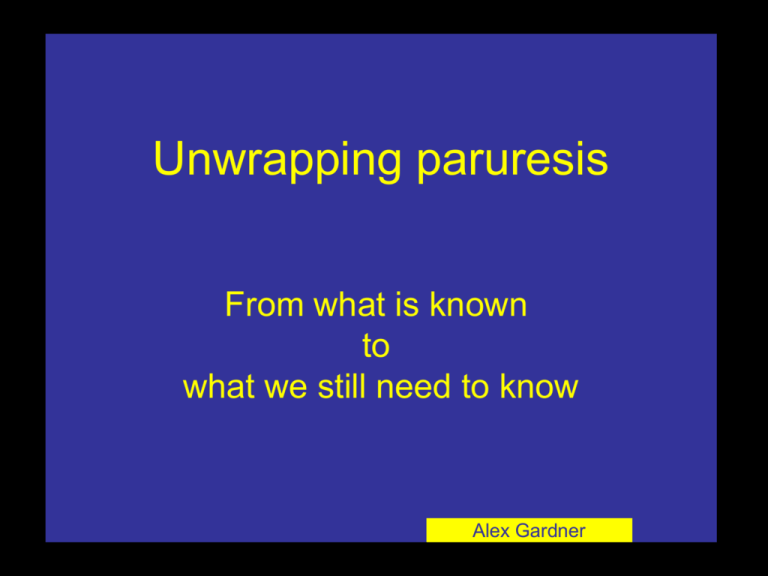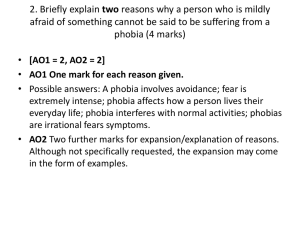Personality profile of paruresis (Gibbs 2004)
advertisement

Unwrapping paruresis From what is known to what we still need to know Alex Gardner Personal position Known to others Known to self OPEN AREA Not known to others HIDDEN AREA INFORM OTHERS Not known to self LISTEN TO OTHERS BLIND AREA RESEARCH You can pee if You are on your own Very likely PARURESIS But not in the presence of others.. Or imagined others Paruresis can range from Slight and transient through to Extreme and very debilitating It can cause considerable bladder problems if not treated I keep six honest serving-men (They taught me all I knew); Their names are What and Why and When And How and Where and Who. Rudyard Kipling At the outset it is important to clarify The difference between Failure to Pee due to: Organic factors Marked by a difficulty to urinate on demand even at Home when alone Psychogenic factors Marked by the inability to pee in the presence of others….. But OK at home The Secret Phobia? DSM IV 300.23 classified this as a social phobia and because of the excessive secrecy, it was also known as the secret phobia. 7% *of the population are believed to be affected. That is about 4 million paruretics in the UK It affects both men and women and prevents them using public toilets or urinating in their own home when others are present. Now considered to be a Social Anxiety Disorder this change has implications for treatment A 1997 social phobia sub-analysis done at Harvard Medical School from the 1994 National Co-Morbidity Study indicates that 6.7% of a RANDOM sample of people( U.S.) said that they have difficulty using a public toilet away from home. A Canadian study of Social Phobia in community surveys in Winnipeg, Manitoba, and Alberta showed that of (N= 1956) respondents, 9.1% (N=178) said yes to fears of "using toilet away from home.” (Archives of General Psychiatry, Nov. 2000) McCullough (2000) usefully makes the distinction between Primary paruresis the inability to urinate around others, Secondary paruresis the importance and meaning we assign to our primary paruresis. Guilt Anxiety Shame Low Self Esteem Helplessness these result in avoidant behaviours with fears of misfires, humiliation, ridicule and overall secrecy Stage 1 The inability to urinate due to unknown factors … but most likely to be a combination of psychological /neurological ones giving rise to the PRIMARY PARURESIS This is the shutdown of the sphincters thus blocking of the Urine Flow It is involuntary and outwith persons control Chocking or Shutdown Self-consciousness has been shown to be a contributing factor of choking in athletes. Situationally self-relevant performance cues had greater influence on highly self-conscious individuals than those with low self-consciousness. For the paruretic individuals, this would apply to perceived scrutiny by others in the restroom Social anxiety research shows that for some people the primary arousal factors are psychological manifestations of self-consciousness and fear (Heckelman & Schneier, 1995). Stage 2 Development of profound emotional psychological components such as guilt shame anxiety etc Thus giving rise to the SECONDARY paruresis. Any hesitancy in urination is not seen as normal but as a confirmation of ones own inadequacy Stage 3 These deep seated psychological factors, perhaps as a result of a learning curve similar to the development of known accepted phobic states, produces an avoidant reaction with greater anxiety. I would call this TERTIARY paruresis characterised by avoidant behaviours reinforcing the primary and secondary events It is different from other phobic states in that the avoidance does bring feelings of security by withdrawal Perception of threat FEAR ON OFF Disappointment Avoidance of threat is reinforcing RELIEF OFF ON Hope People with AP would believe that in the toilet setting and in proximity to other people (or belief that others might be present) the best way to cope with the pressures was to avoid: a) busy restrooms, b) urinals. Taking a choice of stalls if there is a real pressing need, even then there may be problems c) standing in the stall and hence sitting down to urinate etc These and other strategies could be seen as avoidant behaviours This avoidant response gave rise to the early belief that AP was a phobia, and the belief that it must be treated like other phobic states. This error in thinking is perhaps why certain therapeutic approaches did not work well. (eg hypnosis) Reviewing the evidence confirms that this is more likely to be a Social Anxiety Disorder Failure to speak about it gave the term the Secret Phobia Stage 4 as a result of all of the above it can give rise to feelings of being abnormal and the further shame/guilt makes them fail to communicate the problem or seek help. the excessive hiding away of the issues is again a well recognised component of AP. Parurectics • will not tell partners or friends • will not attend social functions • may avoid certain work situations • will not go on holiday • attend theatre • become secretive about their actions • become skilled at keeping their secret Deception Secrecy Act of commission Act of omission Sets up False beliefs Evades True beliefs Therapy SECRECY releases Thought suppression Thoughts hyper accessible enhances Thought Intrusion After Wegner Ironic processes Private self-consciousness is a primary factor in urination breakdown and provides a stronger argument than the anxiety model does. The self-consciousness ‘freezing’ model is based on the choking under pressure model of behaviour breakdown. It centres on attentional shifts from pressure inducing environmental cues (judgement/fear at the urinal) to the self, creating increased levels of private consciousness and self-ruminating thoughts. The pressure to micturate rapidly increases and attention is directed to its complex processes. However, the harder an individual tries the less chance there is of success IDENTIFICATION (Past) Physical/Sensory Cognitive Affective ORIENTATION (Present) Needs Attitudes Beliefs ANTICIPATION (Future) Personal Social Interactional REAL WORLDS Real Worlds1 Prof A.Gardner APPROACH AVOIDANCE APPROACH AVOIDANCE AVOIDANCE APPROACH Real Worlds1 Prof A.Gardner Hesitancy is not unexpected Failure is expected The more there is FAILURE The more is it EXPECTED Because of the secrecy surrounding paruresis little is formally known and research is very difficult to undertake So “ evidence” is from anecdotal sources and one internet research (Gibbs 2001) Of the 4 million people affected Males/females Are in the ration 9/1 t oile t possible w alk s ay w or k situation pe e toilet loca l go first ow n happe n come tak e try time ano ther can then fear pr oble m pee difficult f eeling w ait w ill many gr eat social unable public s go step myself ur in al life find other able life hav e cu bicle cont rol cons cious be f eeling think secret condition k now be lie ve time do no man he lp o nly don m ay bla dder me ye ar i m a ke get pr oblem all syndr ome po sting docto r any friend w ife da Three reported times for onset; a.Infant age 3 – 5 b.Early teens age 11-15 c.adult Gibbs (2004) study of Avoidant Paruresis (AP) is the first one ever carried out on this condition and the perceptions of people with AP. N=264 adult paruretic males aged 18 –80 completed a global, anonymous Internet survey over a 4 month period in 2004. Participants were invited to complete the survey on line accessing the questionnaire on paruresis advice web sites. These were mainly in the USA Europe and Australia. Men’s health and university web sites were also used. Gibbs constructed the Paruresis Severity Questionnaire (PSQ) specifically for this research The six self-report measures were used Paruresis (PSQ) Specific Social fears (SPSQ) Private self-consciousness, (RRQ) Specific social anxiety, (SCS Generalised social anxiety, (SIAS) and the Big Five personality traits. (BFI) Personality profile of paruresis (Gibbs 2004) 1. Compared to community norms (A) men were significantly higher on: •INTROVERSION Introspection/ socially withdrawn •NEUROTICISM Nervous and anxious •CONSCIENTIOUSNESS Reliable; attention to detail •PRIVATE SELF CONSCIOUNESS a) Rumination Negative self evaluation b) Reflection Positive self interest & awareness (B) Men scored within normal range on; •OPENESS •AGREEABLENESS Pleasant, kind, trustworthy Public self consciousnessconcern over other’s scrutiny Personality profile of paruresis (Gibbs 2004) 2. Paruresis and Social Phobia Paruresis outcomes are consistent with social phobia diagnosis as follows 1. Anticipatory fears of needing to pee in public 2. Avoidance behaviour is present (fear of restrooms) 3. Concern over scrutiny of others (fear of restrooms) 4. Onset in adolescence 5. Tendency to worry, be oversensitive, easily embarrassed Personality profile of paruresis (Gibbs 2004) 6. Often related to a specific event e.g Bullying teasing at school urinals etc. NOT consistent with social phobias A) Normal levels of trait like scrutiny of others (PubSC) B) Excessive tendency to self-focus C) Introversion Personality profile of paruresis The results suggests that Paruresis is an unique form of Social Anxiety Disorder consistent with men who are articulate, sensitive, functional, talented and not excessively anxious However the inability to undertake the natural process of peeing, when in the presence of another, can be an extremely debilitating phenomena. Stresses can build up The consequential personal, family, social and vocational deficits render living with paruresis very difficult PSQ Individual Items: Frequencies for Psychosocial and Psychosomatic Issues, and Perceived Etiology of Paruresis Personal experience _____________________ % YES ______ 1. Do you fear other’s negative judgement if you can’t begin urination? 91.7 2. Do you ever feel embarrassed when having urination problems? 95.8 3. Do you tend to blush when having urination difficulty? 46.2 4. If others are close by, do you become self-conscious and self critical when having problems urinating? 96.2 5. Do you sweat, tremble, have a dry mouth or heart palpitations when you fail to begin or complete urination? 50.8 __________________________________________________________________ What do you believe was the cause(s)? (l) Anxiety 52.3 (h) Shyness 51.2 (j) Embarrassment from failing to urinate successfully 48.0 (k) Low self esteem 36.7 (b) Teasing 16.0 (d) Strict parenting 15.6 (c) Harassed at urinal 15.2 (a) Bullying 11.3 (g) Verbal abuse 8.6 (i) General blushing problem 3.1 (f) Physical abuse 2.7 (e) Sexual abuse 1.6 This can affect Mental health Physical health Employment Social Activities Holidays Relationships Leading to self imposed Social isolation Gardner’s (2000) epilepsy study (N=4,500) findings suggested two processes that may be involved in this kind of withdrawal from social interactions IMPOSITION LIMITATION Just so you got the message! Paruresis stops people peeing It breaks up relationships It limits social behaviour Social Phobia ??? but now perhaps a Social anxiety disorder There is much we do not know…hence… We must rely on developing communications Informing front line professionals Establishing TRANSDISCIPLINARITY meetings Developing research 3 P’s Pre-disposing factors Genetics organic psychological Precipitating factors Trauma conditioning experiences Perpetuating factors Personality avoidance strategies We aim to pee Alex Gardner in Suffering the slings and arrows of outrageous fortune ( Ed Bernie Warren) Rudolphi press http://www.interdisciplinary.net/publishing/idp/eBooks/shhindex.html






